By © Gil Dekel (PhD Art design & Media, & MA Cultural and Arts Management).
Table of Content
2. Background and Acknowledgement
6. Tate Organisation
– 6.1 History and Legal Status
– 6.2 Structure
– 6.3 Operations
– 6.4 Vision
– 6.5 Mission
– 6.6 Market Strategy
7. Financial Review
– 7.1 Income and Expenditures
– 7.2 Average Growth and Current Ratio
– 7.3 Capital Structure Analysis
1. Executive Summary
Tate is a successful and profitable UK-based art-galleries organisation. This financial audit evaluates Tate’s financial statements for 2004-2011, and offers the following recommendations to build up profits and sustainability:
– Tate needs to focus on debt financing.
– Net income is unstable, and should be rectified.
– Long term assets show strong position, but could be managed to produce more income than they currently do.
– Equity/net worth position is growing consistently but overall financial position could be improved.
– While Tate focuses on new (and much needed) capital expenditures, there is also a need to improve current capital position.
– Financing leases are currently paid with a massive single payment. Future pays could be structured in instalments.
2. Background and Acknowledgement
This audit was carried out as part of my MA course (Cultural and Arts Management), and submitted Dec 2011. It has been reviewed by my tutor at the University of Winchester, and his suggestions were applied to this document.
I decided to tackle one of the most challenging topics for me – finances and accounts – and carry out financial audit. Tate was chosen as I admire this organisation’s art exhibitions and scope, and I was looking to learn from a successful art establishment.
Many individuals have helped me in this project: family, friends, librarians, professional colleagues, secondary sources (print and online), and other sources of inspiration and motivation.
All rights © Gil Dekel. Do not make any use or copy of this work or any part of it.
3. Aims
This audit aims to compare Tate’s financial statements for the last seven years, evaluate them, explore patterns, review risks, management control and business progress; and offer recommendations.
4. Scope and Limitations
Tate’s Financial Statements for 2004-2011 which are available online.
Tate is a large organisation, and there are many elements to its operation and finances that cannot be drawn from its financial statements alone. The following audit is limited to drawing conclusions from the financial statements and from information available on Tate’s website.
5. Method
Review and comparison of Tate’s Annual Accounts 2004-2011, which are available on Tate’s website, and review of information on Tate available on its website and other websites.
The review was carried as follows:
– Evaluation of current projects.
– Financial Statements overall review, including review of future plans.
– Review of management’s control over operations and financing.
– Review of Tate’s compliance with the law, ethical standards, corporate governance and regulations.
6. Tate Organisation
Tate is a public institution, consisting of four art galleries: Tate Britain (1897), Tate Liverpool (1988), Tate St Ives (1993), Tate Modern (2000); with a fifth dimension being Tate Online.
Tate is responsible for a national collection of over 65,000 works, and for exhibiting British, Modern and Contemporary Art, as well as for increasing the public’s knowledge of arts through art programs and activities. [1][2]
1. http://www.tate.org.uk/about/theorganisation
2. http://www.tate.org.uk/about/theorganisation/history
6.1 History and Legal Status
The gallery was founded in 1897 at Millbank, London, as the National Gallery of British Art, and was commonly called the Tate Gallery after Henry Tate.
The National Gallery and Tate Gallery act came into force in 1955, and separated the legal status of Tate from the National Art Gallery.
The Museum and Galleries Act 1992 established the Board of Trustees as a corporate body and defined the Boards’ function. The Act also recognized Tate as an exempt charity.
In 2000 Tate Gallery was rebranded as Tate.
Today Tate is a non-departmental public body (NDPB) under the auspices of the Department for Culture, Media and Sport (DCMS). [3][4][5]
3. http://www.tate.org.uk/about/theorganisation/history
4. http://www.bmukk.gv.at/medienpool/16125/beard.pdf
5. http://www.tate.org.uk/about/governancefunding/funding/accounts_20102011.pdf
6.2 Structure
Current Tate’s Director, Sir Nicholas Serota, was appointed by the Board of Trustees with the approval of the Prime Minister. [6]
Tate departments consist of curatorial and learning departments at each of the four gallery sites, as well as umbrella departments responsible for Tate-wide activities:
– Director’s Office: Strategy and Policy, Corporate Governance, External Relations, and Administration.
– Tate National: national and international strategies, research and education.
– Transforming Tate Modern Project Team: Tate Modern expansion project.
– Development: fundraising activities (Corporate Support and Events, Trusts and Public Sector, Individual Giving, the US Development Office and the Tate Foundation).
– The Tate Media and Audiences: Tate Online, Tate Media Productions, Communications (Press, Marketing and Design), Membership and Ticketing Services.
– Collection Care: care, storage and record of the collection.
– Finance: finances and compliance with NDPB legislative and administrative requirements.
– Visitors Services and Estates: Tate’s buildings facilities, safety and security.
– Human Resources.
– Tate Enterprises Limited: restaurants, cafés, shops and ancillary services. [7]
6. http://www.tate.org.uk/about/governancefunding/funding/accounts_20102011.pdf.
7. http://www.tate.org.uk/about/theorganisation/structure/departments/default.htm.
6.3 Operations
Tate Britain hosts artworks from 1500 to present day, while the other three Tate’s galleries – Tate Liverpool, Tate St Ives and Tate Modern – hold International and Contemporary Art. [8][9][10][11]
Tate’s four aims are:
– To care for, preserve, and increase arts and documents
– To exhibit art
– Expand access for researchers
– Promote the public’s enjoyment and understanding of arts.
Primary strategic objectives are:
– The art in Tate’s care
– Public audiences
– Tate’s organisation and ways of working
– Tate’s future development. [12]
Tate focuses on two main operations: the collection & maintenance, and exhibition & activities.
In the first operation activity Tate collects and maintains artworks of national and international artists, paintings, sculptures, antiques and other cultural heritage.
The second operational activity consists of exhibiting arts in the galleries and online, arranging events and learning programmes, and selling art-related products.
Tate generates funds and income through the exhibitions and e-commerce of art-related products such as calendars, diaries, games and artist items. Tate trading subsidiary, Tate Enterprises, generates funds from its publishing, retail and catering activities, contributing a £3.7 million to Tate (2010-2011). Another revenue stream consists of sponsorships and memberships. [12]
Tate Enterprises helps Tate generates over 60% of its income by itself, with the additional support of individuals, foundations and corporates. Tate is closely connected with three independent charities that do not impact on its operating policies but supports Tate: Tate Members, Tate Foundation, and The American Fund for the Tate Gallery and The American Patrons of Tate. [12]
UK Government funding accounted for 38% of Tate’s income (2010-2011). [13]
8. http://www.tate.org.uk/britain/
9. http://www.tate.org.uk/modern/
10. http://www.tate.org.uk/liverpool/
11. http://www.tate.org.uk/stives/
12. http://www.tate.org.uk/about/governancefunding/funding/accounts_20102011.pdf
13. http://www.tate.org.uk/about/ourpriorities/improvingtheorganisation.
6.4 Vision
To create a sustainable permeable institution, removing barriers to Tate’s buildings, arts, programmes and events, and offering employment opportunities that are open to all. [14]
14. http://www.tate.org.uk/about/governancefunding/funding/accounts_20102011.pdf
6.5 Mission
To increase public enjoyment and understanding of art from the sixteenth century to the present day [15], by being more open to new ideas, diverse, international, stimulating, and sustainable.
15. http://www.tate.org.uk/about/governancefunding/funding/accounts_20102011.pdf
6.6 Market Strategy
Tate’s strategy focuses on four main areas of activities: Arts and Ideas, Audiences, Improving the organisation, and Future Developments. [16]
16. http://www.tate.org.uk/about/ourpriorities
6.6.1 Arts and Ideas
Tate conceived itself as a distinctive place of sharing and enjoying arts, and as such it is now looking at developing a more global position. New programs will be introduced and scholarships announced to support research in the arts. [17]
17. http://www.tate.org.uk/about/ourpriorities/artandideas
6.6.2 Audiences
Tate enjoys worldwide visitors to its galleries and website. To continue support audiences, Tate is introducing new learning and engagement materials, new multimedia guides, and extending its galleries opening hours. [18]
18. http://www.tate.org.uk/about/ourpriorities/audiences
6.6.3 Improvements
In order to become more efficient organisation and maximise the use of resources, Tate is employing skilled staff that can focus on using the minimum of materials required. [19]
19. http://www.tate.org.uk/about/ourpriorities/improvingtheorganisation
6.6.4 Future Developments
As visitors’ numbers increased dramatically over the years, Tate has embarked on projects to expand its physical premises to increase exhibitions spaces and provide more learners’ areas and resources. [20]
20. http://www.tate.org.uk/about/ourpriorities/futuredevelopment
7. Financial Review
A review of assets, net assets, liabilities, revenues, expenses, funds, and cash flow from 31 March 2007 to 31 March 2011, will be detailed in section 7.1.
Section 7.2 reviews average growth and current ratio for the last seven years, and Section 7.3 provides Capital Structure analysis.
7.1 Income and Expenditures
Income and Expenditure statement (Table 1) indicates a negative growth for 2011 compared to previous years.
Total income from resources (£xxxx) less total resources expenses (£xxxx) leaves just over £xxxx net income, which is relatively small income for an organisation like Tate. This situation means that Tate will not be able to meet non-recurring or unexpected expenses. Funds Carried Forward are likewise in decline since 2006.
In a review of Tate’s Income and Expenditures I will focus on:
– Trading income (7.1.1)
– Total incoming resources (7.1.2)
– Trading Costs (7.1.3)
– Total resource expended (7.1.4)
– Balance Sheet – funds carried forward end of each year (7.1.5)
7.1.1 Trading Income
Trading Income has grown by 10.2% in 2008-09 but declined sharply by 7.1% in 2009-10, only to increase again in 2010-11 by a humble 1.5%. These unstable changes should be observed.
On a positive note, it is observed that there is a positive growth of 1.5% for recent year 2010/11.
It is recommended that a constant level of growth in trading income is maintained in order to help expand Tate’s operations. Tate could look into efficient ways of raising more income through trading.
7.1.2 Total Incoming Resources
Total Incoming Resources consist of:
– Trading income
– Other activities for generating funds
– Investment income
– Grant in Aid
– Other income from charitable activities
– Other incoming resources.
An unstable trend is observed in Total Incoming, with a steady growth from 2006/7 through to 2008/9, followed by a decline for 2009/10, and a rather small percentage increase of 2.1% for 2010/11.
This trend seems in line with trends of Trading Incomes, and may reflect on the recent so-called economic crisis in the UK (during 2009-2010).
Tate’s financial activities (Table 1, Section 7.1) indicate that Trading Income and Grants in Aid are an important income source. Yet, Tate’s 2011 Financial Statement [21] suggests that Government’s grants will be reduced by 15% through to 2014. Tate needs to prepare for this situation in order to maintain the level of its incoming resources.
21. http://www.tate.org.uk/about/governancefunding/funding/accounts_20102011.pdf.
7.1.3 Trading Costs
Trading Costs take up more than 90% of the trading income each year. In years 2007/08 and 2008/09 Trading Costs consumed xxx% and xxx% of Trading Income respectively. This is rather high percentage, and it is recommended that Tate revaluate its performance costs in generating trades, and look into ways of decreasing these costs.
7.1.4 Total Resource Expended
Total spending consists of:
– Trading costs
– Other costs of generating funds
– Investment management costs
– Charitable activities
– Governance costs
– Other resources expended.
Total Resources Expended seen a growth from 2006/07 through to 2008/09, but a decline for 2009/10.
Of the Total Resources Expended, charitable activities and trading costs are key spending (table 1, section 7.1). It is recommended Tate focus on reducing these key spending, to increase its income over expenses.
7.1.5 Balance Sheet
Tate’s overall assets declined in 2011, as the result of falling Current Assets as well as payments made (which reduced Current Liabilities).
The only aspect in 2011 which shows growth is equity.
Long term debts (which consist of leasing) have been reduced vigorously in 2010 and 2011. This was due to end of lease terms, and could also be caused by strict debt terms which meant that Tate was unable to produce debt financing.
Tate should focus on debt financing to finance its capital expenditures and/or current assets.
Reviewing the Balance Sheet I will focus on:
– Net Assets (Non-current assets, Current Assets, and Current and non-current liabilities) (Section 7.1.5.1)
– Equity and Endowments (Section 7.1.5.2).
7.1.5.1 Net Assets
2009/10 seen a major decrease in net working capital, which may indicate on massive borrowings for that year. Financial Statement for 2011 indicates that in 2010 Tate repaid these borrowings in a short time. Tate may be financing its short term expenditures or expanding its operations in other areas. The management used its deposits to pay borrowings in 2011. [22]
22. http://www.tate.org.uk/about/governancefunding/funding/accounts_20102011.pdf.
7.1.5.2 Equity and Endowments
Cash Flow 2007-2011.
Tate is closing with negative cash increase. Tate’s financial statement for 2011 [23] reveals that Tate has paid for financial lease with cash in 2010 which may be the cause for the massive decrease in cash. This payment reduced current and total assets as well. Yet, Tate managed these payments effectively and handled cash flows by liquidating some current assets such as deposits [23].
While purchases of investments and fixed assets are consistent with past purchases, the overall decrease in cash in 2011 was abnormal against Tate’s capital structure.
Cash inflow from operations is strong for 2011, yet is lower than year 2010, and is in a decrease since year 2009. Tate is using cash in 2011 to pay for expenses.
Cash inflow from return on investments has decreased in years 2010 and 2011, reflecting the recent climate of so-called financial crisis.
For year 2011, cash outflow from capital expenditure was £xxxx, indicating on Tate’s expansions of operations, the buying of components (lands and buildings), as well as investments. [23]
Tate should look at reducing its capital expenditures in the future, and acquiring capital with more flexible terms.
23. http://www.tate.org.uk/about/governancefunding/funding/accounts_20102011.pdf.
7.2 Average Growth and Current Ratio
7.2.1. Average Growth
Table 4 indicates that average growth rate of assets and funds, for the past seven years, is around 114%. This means that if there are assets worth £100 million in a year, then the following year they will worth £114 million.
Balance Sheet figures (Table 2, Section 7.1.5) for debtors and prepayments, creditors and security deposits are observed to be at normal level, as they shown neutral behavior (no substantial increase or decrease).
7.2.2. Average Current Ratio
Table 4 shows that average Current Ratio for the last seven years is 8:1 (assets worth £8 are available for a loan of £1 payable in next 12 months). This is satisfactory, yet Tate’s cash situation is critical. Cash available against creditors is 0.7:1, which means that only 70 pence are available as cash and highly liquid assets (three months liquidity) against a £1 loan which has to be paid over the next 12 months.
7.3 Capital Structure Analysis
Tate’s Net debt to Net Capital ratio is consistently decreasing, and reached a negative position (-2%) in 2011 which reflects on Tate improving its credit power. This will help Tate acquire debt more easily in the future.
Fund being carried forward each year is unstable for 2007-2011. There are many factors that can contribute to this situation; each requires a thorough and occasional analysis.
Asset turnover ratio is consistent each year, and starts growing in 2011 which indicates on a good use of assets.
Return on Equity figures, which are based on Net Income (Net movement of funds) do not indicate a strong position. Likewise, figures for Return on Equity based on sales are consistently decreasing over the years, and are not strong for 2011. Tate should define plans to improve this situation.
Fixed Assets against total assets for 2011 are almost 95%, which shows that Tate operates with 95% fixed assets and only 5% portion assigned to current assets. In this situation Tate does not (or cannot) acquire debt to finance capital or operating expenditures.
Fixed asset turnover ratio is also decreasing over the years, and may continue to decrease unless action is taken by Tate.
Operating income against debt is consistent and stable over time, but in 2011 debt payments increased this ratio to 482%.
8. Recommendations
The overall performance of Tate organisation is excellent, yet there are few recommendations:
– Current Ratio is good, but cash and liquid assets available are not healthy. Cash level could be improved. This can be done by increasing creditors’ settlement period (currently 30 days). (see Table 3).
– Prices of items sold online could be reduced. Attractive Sales, such as ‘Buy 3 for the price of 2’ could be introduced. Paying visitors to the galleries could be given discount coupons to purchase items online.
– Deposits decreased in 2011 (see 7.1.5.1; 7.1.5.2), which reduced overall current assets level (see 7.1.5 Table 2) and which will make it challenging to acquire borrowings. Current asset level for year 2011 indicates less profitability in the future.
– Long term Assets are not generating expected revenue and income, as expenses are at high level indicating high level of fixed assets maintenance costs. Plan to reduce these costs are required.
– The company relies on grant aid for its revenue (see 7.1 Table 1), but this will be reduced in the following years. Plans to increase alternative revenues are required.
– Total debt level in year 2011 was reduced in a short period (see 7.1.5), which may cause current and future growth to increase less than expected.
9. Conclusion
The performance of Tate is impressive. The administration and staff are skilled and expert in their fields. Tate adheres to its written policies and complies with the law.
Tate market strategies are well defined and easy to understand and follow up. Tate financial statements are indicative and provide a clear position of the organisation.
If Tate maintains a consistency in applying its core activities and operations in line with its policies, as it has done so far, then Tate will see itself coming closer to achieving its aims and objectives.
Tate should increase its current asset level to achieve high growth in income and should reduce total resources expended. There is also a need for more focus on debt financing. Tangible fixed asset acquisition should be monitored closely, as Tate embarking on massive and costly expansions. Deposits at bank should be increased to fund operating expenses and increase cash level.
10. Swot Analysis, Tate Gallery
10.1 Strengths
- Impressive collection of some 65,000 items of British and International art. [24]
- Provision of comprehensive guides and interpretation resources about the collection, to facilitate enjoyable and educational visits by visitors.
- Adherence to guidance, such as the following of the Charity Commission’s general guidance on public benefit. [25]
- Exhibitions that serve as new ways of interpreting past and present events, casting new perspectives on heritage and present times. [25]
- The ARTIST ROOMS collection of international contemporary art (owned jointly with the National Galleries of Scotland) on tour in UK cities, increasing Tate brand.
- Technology leader: strong online research tool to attract students and funding, with the entire collection available to search and view online. [26] Art works can be searched by artist name, date, medium and other categories. [25] Strong social media followers, with Tate’s Facebook fans over 190,000, and over 320,000 followers on Twitter. Ipod and iphone apps also available.
- A reliable organisation which attracts the support of artists, individuals, institutions and the government.
- Strong educational activities, with the ‘turbinegeneration’ programme that link schools from around the world being granted the UNESCO patronage. [25]
- Participant of Google Art Project.
- A national resource with one of the largest regional lending programmes in the UK. [25]
- Capacity to reach out to other countries. Strong international presence with growing number of collaborations, exhibitions and loans (artworks lent to 118 venues worldwide during 2010-11). [25]
- Excellent leadership and management. Many staff recognised experts in their field. [25]
- Pedagogical capacity to fill up the gap where no formal training is availability elsewhere in the UK for the programme of museum collection care and management. [25]
- New website is being designed with scalability in mind, meaning it will easily accommodate future developments, thus save on future costs. [25]
- Expansions of Tate St Ives, Tate Modern, and Tate Britain Millbank will enable more exhibition spaces, as well as a much-needed learning studios and public spaces. [25]
- Changes to visitors’ data collection, collected on a weekly basis throughout the year, with more accurate measurement of audiences.
- Good marketing abilities in countries that are still out of reach of many of Tate’s competitors.
- Capacity to generate more than 60% income by itself. [27]
- Excellent visitor satisfaction, with more than 94% recommended a visit to others. [25]
24. http://www.tate.org.uk/about/ourpriorities/artandideas
25. http://www.tate.org.uk/about/governancefunding/funding/accounts_20102011.pdf
26. http://www.tate.org.uk/about/ourpriorities/artandideas
27. http://www.tate.org.uk/about/governancefunding
10.2 Weaknesses
- Corporate funding for learning programmes decreased by 28% in 2010-11. [28]
- Falling funds carried forward.
- Low reserves.
- Current content on website not organised well.
- Diverse art styles collections that are not fully complete, rather scattered among few galleries in UK and around the world, thus audience do not get a change to view the full collections.
- Expensive prices of items sold online.
- Tate is expanding its collections not steadily but rather abruptly [29] which can become a weakness if staff may not be able to contain the works, or if unexpected increase in fund will be required to maintain the expansion.
28. http://www.tate.org.uk/about/governancefunding/funding/accounts_20102011.pdf
29. http://www.tate.org.uk/about/ourpriorities/futuredevelopment
10.3 Opportunities
- Expanding to regions in UK where people have less access to art, and increasing art awareness among people who do not necessarily show an interest in arts.
- Changing trends in society and the influence of new research in art history means that there is continuous rethinking of Tate’s collections, with the opportunity to reveal new ideas and meanings to the existing arts, hence increase value and interest of the collection.
- The popularity of Social Media can help Tate grow its national and international connections and affluence.
- A growing global art market.
- More tax reliefs available for non-profit organisations.
- Tate’s industry business largely recognised and supported by the UK society.
- Current government funding cuts mean more fundraising activities will be required, which can become an opportunity for Tate to increase its self-generating income and thus reduce reliance on governmental income sources.
10.4 Threats
- Recent economic climate reduced Grants in Aid.
- Tate’s freely disclosed financial statements is a requirement, yet can become a threat as competitors can review Tate’s full finances.
- While Tate generated more than 60% income, still it relies for the other 40% on the government. [30]
- Cash position is not strong, yet at the same time Tate is now doubling its physical areas of exhibits, an investment which requires huge funds. [31]
30. http://www.tate.org.uk/about/governancefunding
31. http://www.tate.org.uk/about/governancefunding/funding/accounts_20102011.pdf
Appendix
Balance Sheet (projected to 2015)
xxx…
Income Statement (projected to 2015)
xxx…
Cash Flow statements
xxx…
© Gil Dekel. 22 April 2012. Update 24 April 2013.
It is illegal to use or copy any part of this page/website.
For help, you can contact Gil here.

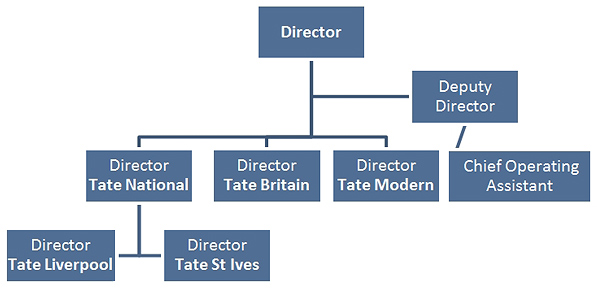
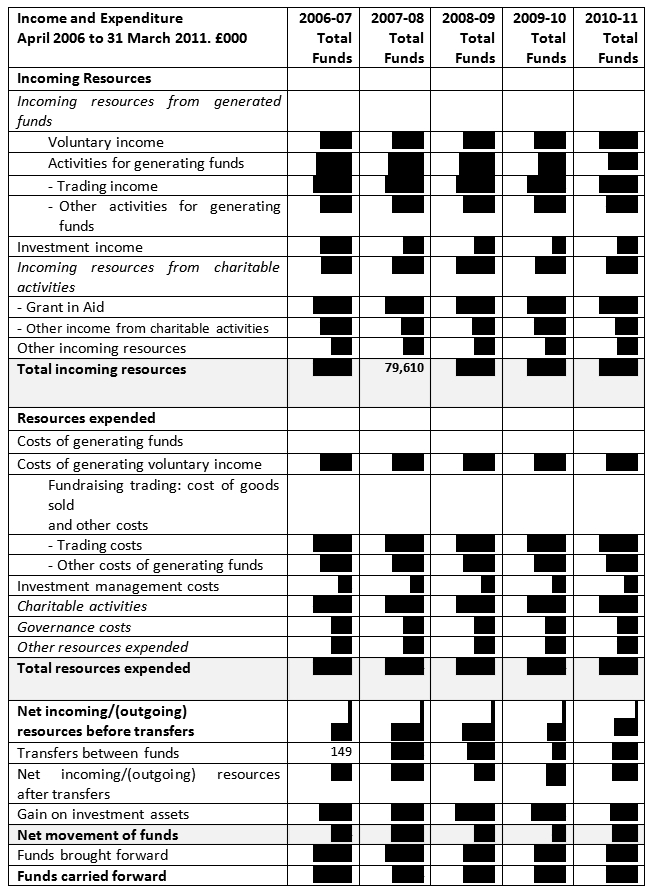
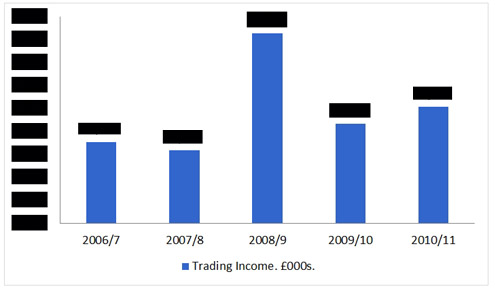

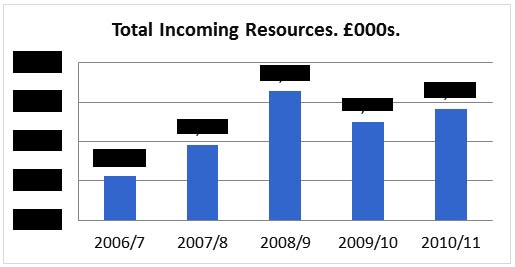

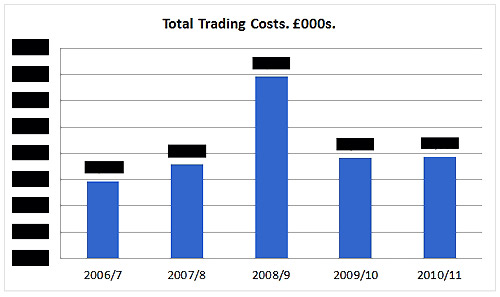

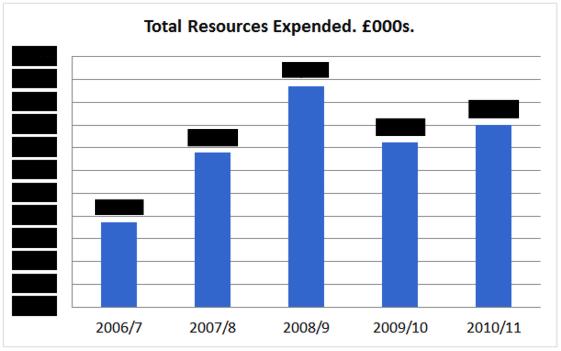

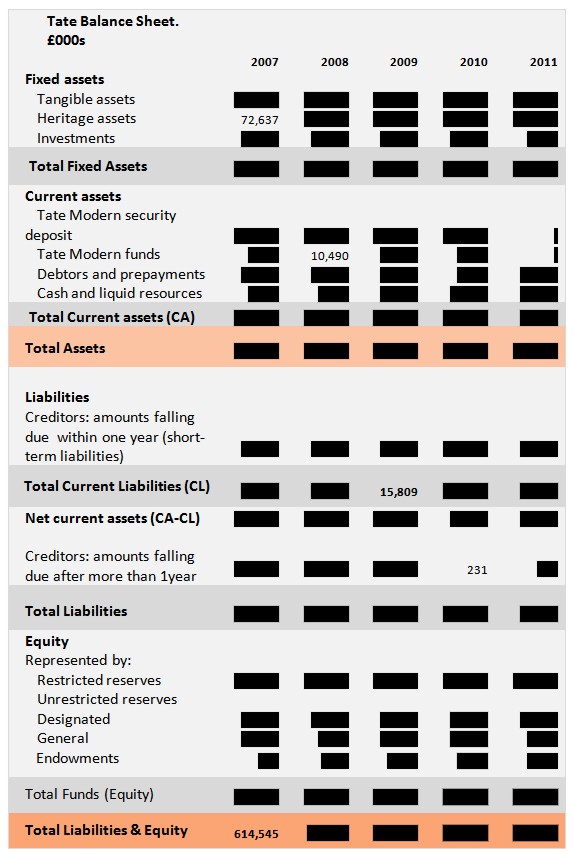
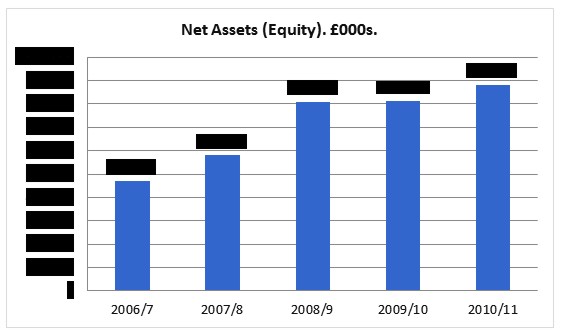
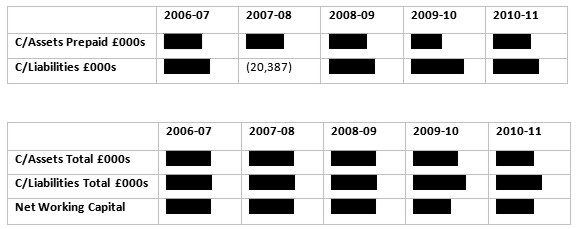
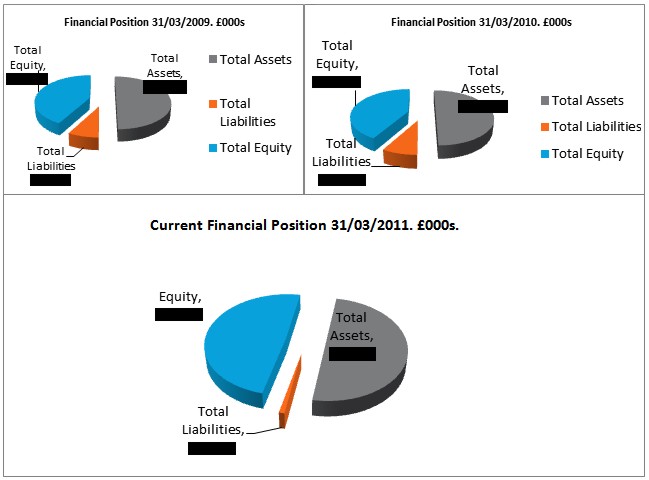

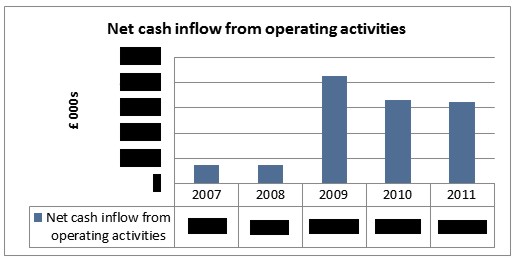
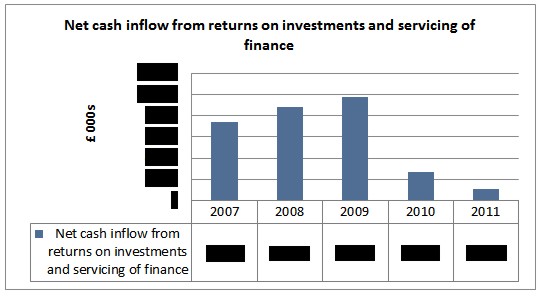
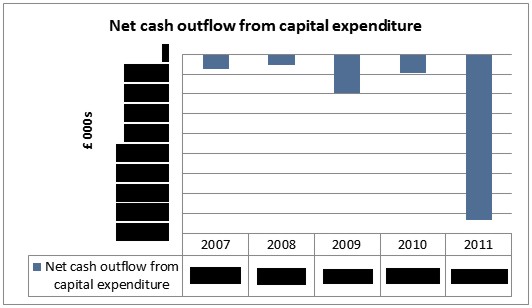
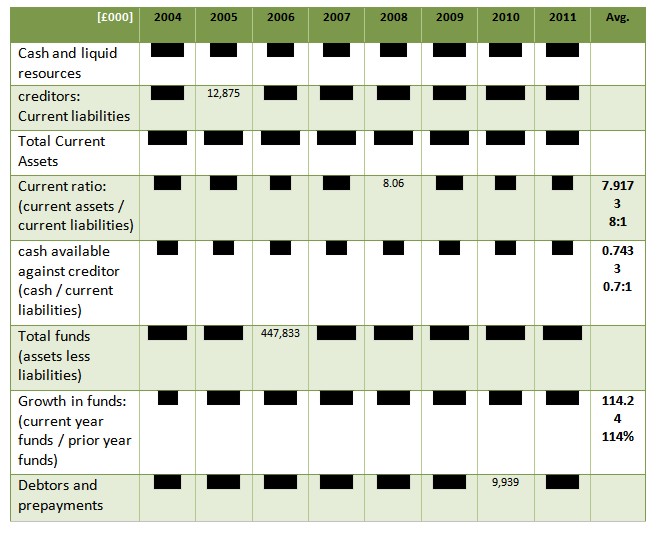
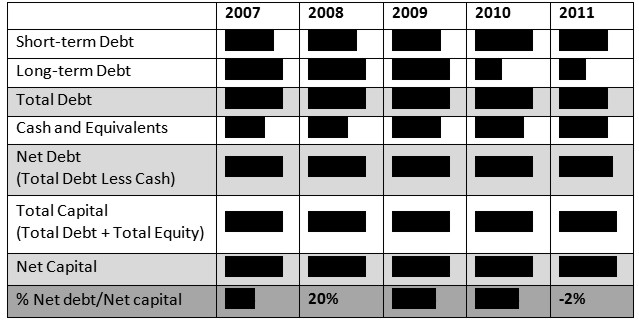




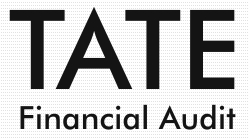

 - Reading with Natalie, book here...
- Reading with Natalie, book here...